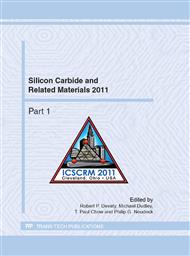p.117
p.121
p.125
p.129
p.133
p.137
p.141
p.145
p.149
Use of Vanadium Doping for Compensated and Semi-Insulating SiC Epitaxial Layers for SiC Device Applications
Abstract:
Vanadium doping from SiCl4 source during epitaxial growth with chlorinated C and Si precursors was investigated as a mean of achieving compensated and semi-insulating epitaxial 4H-SiC layers for device applications. Thin epilayers were grown at 1450°C with a growth rate of ~6 μm/h. Experiments at 1600°C resulted in the growth rates ranging from 60 to 90 µm/h producing epilayers with thickness above 30 µm. V concentrations up to about 1017cm-3 were found safe for achieving defect-free epilayer surface morphology, however certain degradation of the crystalline quality was detected by XRD at V concentrations as low as 3-5x1015 cm-3. Controllable compensation of nitrogen donors with V acceptors provided low-doped and semi-insulating epitaxial layers. Mesa isolated PiN diodes with V-acceptor-compensated n- epilayers used as drift regions showed qualitatively normal forward- and reverse-bias behavior.
Info:
Periodical:
Pages:
133-136
Citation:
Online since:
May 2012
Keywords:
Price:
Сopyright:
© 2012 Trans Tech Publications Ltd. All Rights Reserved
Share:
Citation:


